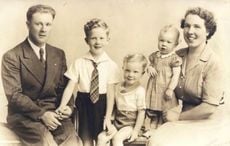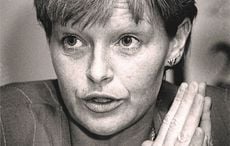| St. Mel's Cathedral |
It was the lot of the Celtic Times to return to the sweet auburn country of County Longford over the weekend, having previously spent the tropical downpours of late spring 2006 to the eve of that same year there conducting an audit of that same St. Mel’s Diocesan Museum Collection at the behest of the National Museum of Ireland.
It was one of the most eclectic and prestigious collections in Ireland, with a rich diversity of material from the Neolithic to the modern age, constituting mostly archaeological, folklife, numismatic and ecclesiastical artefacts but also political, military, ethnographic and geological displays. Longford County Council in partnership with the Heritage Council, commissioned my historical management services, Boru Cultural Enterprises to conduct the said audit, which took place on site at the once towering St. Mel’s Cathedral in Longford town.
----------------------
READ MORE:
Ancient Irish title dies with the death of the last Knight of Glin
Irish burial rituals - skeletons reveal fear of the undead
Top ten scariest monsters and demons from Celtic myth - PHOTOS
----------------------
The aim of the project was to document the collection of approximately 450 artefacts currently on display in the museum. This entailed the drawing up of a Collection Management Plan, creation of a database methodology, conservation analysis, preparation of a research plan and showcase layout along with recommendations.
The past tense is used above because that same irreplaceable collection has been substantially destroyed. The remnants of the collection that was in church ownership in the diocese of Ardagh and Clonmacnois are currently held at the National Museum in Dublin. In the immediate aftermath of the fire, our inventory, which also had the input one of the Europe's leading conservators Dr Adrian Kennedy, had been used by the diocese of Ardagh and Clonmacnois in the initial stages of rescue and consolidation of the remains of the Cathedral.
| Mel Gibson |
They saw for themselves first hand the extent of the recovery work that lay ahead. There is good fight in the Longford folk and one hopes that the surviving collection will find a fitting new home in the town be it at the Cathedral itself or in a purpose built museum location. Who knows, the now vacant Connolly Barracks may have a new tourism and heritage use designated to it yet for the Longfordians.
When arriving into Longford county, one journeys not just into the physical but the spiritual heartlands of Ireland. The landscape here, so beloved of Oliver Goldsmith, would have sparked some of the greatest masterpieces written in the tongue of the Sassenach, such as She Stoops to Conquer and The Deserted Village.
Maria Edgeworth, author of the famed novel Castle Rackrent which was written in 1800 in the wake of the defeat of the French general, Humbert, and the United Irishmen at Ballinamuck, hailed from an establishment family based at Edgeworthstown who owned vast tracts of the county. Her works which were inspired by the Longford peasantry won the acclaim of Scott, Turgenev, Byron and Jane Austen. She died in 1849, soon after the calamitous famine which decimated many of her adopted people, and was buried in a vault at Edgeworthstown church. Also of the soil of Longford was Paraic Colum, who authored She Moved through the Fair and was a prolific Irish writer of the early twentieth century. Leo Casey, author of the Ring of the Moon, resided in Ballymahon, the southern gateway into the county.
----------------------
READ MORE:
Ancient Irish title dies with the death of the last Knight of Glin
Irish burial rituals - skeletons reveal fear of the undead
Top ten scariest monsters and demons from Celtic myth - PHOTOS
----------------------
The Celtic Times took up a brief repose at Cooney’s renowned hostelry in Ballymahon while taking in both a hale and hearty breakfast and the unfolding Australian annihilation at Auckland by the Irish caid playing boys; its special what four of our provinces can achieve together as a nation. It was also both stirring and heart rendering to see them roared on in the stadium itself not just by Irish rugby fans but the tens of thousands of the first wave of the new lost generation of ex pats who have made new homes abroad.
They have done nowt, save only to be born Irish in their Irish motherland, to deserve the lowest, slyest digs of the sleeveen kleptocracy we call our system of governance, a governance that has failed its people and placed it in the grip of economic receivership. It is not too difficult to envisage any fortnight now, which is the regularity with which the life support checks are being signed, that as Berlin sees the fattened largesse and excessive payouts and lump sums still being issued to civil servants that stood as governors and regulators during this surrender, they may yet say that there is nothing in the coffers this week boys.
The Celtic Times states this fully in the knowledge that there are often paybacks for making such statements. It’s a sharp dose of reality many companies, small businesses and self employed across Ireland are already well acquainted with. The Celtic Times though will never confront a problem without proffering solutions. It remains obvious to us in this parish that one of our most potent resources - heritage tourism - needs the slightest bit of management and innovation, and hopefully local agencies across the country like the Longford Community Resources can get the required buy in, and for a relatively small seed investment, considerable economic and social capital is generated.
All the children of the nation have the democratic right to partake equally in this regeneration, not just well versed practitioners of the darker arts of gombeenism and parochialism, for it is due largely to this unashamed cross section of go forward, cop out clowns that we live in what is currently a de facto failed state. Look at it, we have a better endowed, similar land mass to our nearest and dearest neighbours across the sea, a largely well bred, decently fed and educated people, who generally work hard, party hard and have usually conducted themselves well when gathered in droves abroad be it on old battlefields or modern international matches, with a genius for innovation and getting on. We may have a weakness when it comes to a needy want to be held in good esteem in other countries – a want that manifests itself currently in our insane approach to the financial troika as the teacher’s pet – perhaps this can be attributed to a colonised/coloniser complex.
On the whole, not an inherently bad people really. So how in God’s name, can we justify being unable to marshal our resources as a nation to cater for 5 million when sterling John next door, for all his many failings, accounts for 50 million plus in a multi ethnic state.
With this thought process set aside, for now, along with the hale and hearty breakfast, we put ourselves back on the right track in Longford again…..
| Sean MacEoin |
MacEoin himself recalled another prominent family from the War of Independence, from which hailed the much desired Kiernan sisters of Granard. It was during the watershed 1917 Longford by-election which was won by the Sinn Féin candidate Joseph McGuinness, that Collins first came into contact with them, and according to MacEoin, he fell in love with Helen Kiernan, who chose to marry a solicitor, Paul McGovern. Upon this Collins soon turned his eyes towards another sister, Kitty who had already attracted the affections of Harry Boland, Collins’ close friend. This ill-fated love triangle was to have serious consequences for the future fledgling nation state, and Kitty was to lose her fiancé Collins in the devastating civil war to follow.
----------------------
READ MORE:
Ancient Irish title dies with the death of the last Knight of Glin
Irish burial rituals - skeletons reveal fear of the undead
Top ten scariest monsters and demons from Celtic myth - PHOTOS
----------------------
At Dromard, in the most northerly part of the county, lies the unique townland of Fyhora, which marks the meeting of three baronies, three parishes, three counties and three provinces. Just south of here lies Ballinamuck, an area made infamous as the last fatal stand of the United Irishmen and the French invasion of Ireland in 1798. The name of Gunner McGee has always crackled in the background of conversations on Irish independence and it was here, hopelessly outnumbered by the advancing British loyalists, that he won his fame. He had charge of a canon, which he had used to devastating effect.
When he ran out of ammunition, he smashed a number of camp pots and kettles and with these loaded his gun. There was time for just one more discharge at the advancing redcoats. When just ready to fire, one of the stocks of a wheel broke, and the gun could not be fired until two of McGee’s cousins who were manning it, stepped forward and propped it up with their backs while McGee applied the match. The discharge broke their spines and their miserable state was soon put at an end when the British captured the gun and strangled McGee. A British officer wrote of that day:
‘How awful to see that healthy mountain covered with dead bodies, resembling at distance flocks of sheep, for many numbers were naked and swelled with the weather.’
Around five miles to the east lay Aughnacliffe, where there is located here a portal dolmen approximately 5000 years old. This immense stone monument marks a pagan burial site, and is one of the largest of its kind in Western Europe. One of the most famous students said to have attended the local school here is one Mel Colmcille Gibson, the actor and director of works such as Braveheart and The Passion of the Christ. This was in the late sixties when Mel’s father and his Longford born mother Anne Reilly Gibson were relocating their family from New York to Australia, to protect the older of their ten children from the war draft, and also in protest at what they saw was the growing immorality of American society. Mel, their sixth born child, was named in honour of the patron saint of the Diocese of Ardagh and Clonmacnois which incorporates Longford.
| St Mel |
The county town of Longford itself over which St. Mel’s Cathedral had towered since 1840 is a town of fine, hospitable people. It lays no claim to delusions of grandeur, but it has an Irish soul about it that gives the town a taste of more for visitors. It has a decent soccer team, and St. Mel’s college itself has a rich gaelic football pedigree, and is a nursery for the current buoyant county underage teams. Another Longford McGee, Eugene, was responsible for masterminding Kerry’s five in a row downfall in 1982 when in charge of the Offaly boys. When formerly watching the World cup of 2006 in saloons such as Clarkes and Valentines, I was struck by the amount of Poles who bedecked the town on the nights of their short-lived campaign. Many of these have now returned to their original homeland wit a slight Longford lilt.
This is a town and a county where man has found God, craic, tax havens and all the leisure the lordly Shannon can throw up. A place where the land has given up live fish to saints - let that be an image for the resourcefulness that’s required ahead. A place with soul.




Comments